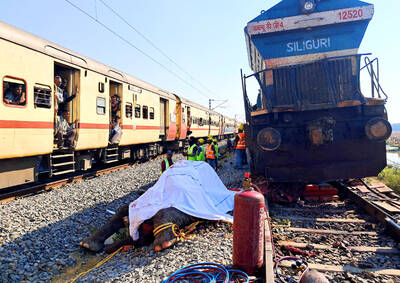One of Europe's leading scientists on Tuesday raised the possibility that the extreme heat wave now settled over at least 30 countries in the northern hemisphere could signal that man-made climate change is accelerating.
"The present heat wave across the northern hemisphere is worrying. There is the small probability that man-made climate change is proceeding much faster and stronger than expected," said Professor John Schellnhuber, former chief scientific adviser to the German government and now head of the UK's leading group of climate scientists at the Tyndall center.
Schellnhuber said "the parching heat experienced now" could be consistent "with a worst-case scenario [of global warming] that nobody wants to come true."

PHOTO: REUTERS
He warned that several months' research would be needed to analyze data from around the world before scientists could say why the heat waves are so intense this year.
"What we are seeing is absolutely unusual," Schellnhuber said. "We know that global warming is proceeding apace, but most of us were thinking that in 20 to 30 years time we would be seeing hot spells [like this]. But it's happening now. Clearly extreme weather events will increase."
Other climate scientists across Europe suggested the present heat wave was perhaps the most intense experienced and linked to global warming.
"We've not seen such an extended period of dry weather [in Europe] since records began," said Michael Knobelsdorf, a meteorologist at the German weather service. "What's remarkable is that these extremes of weather are happening at such short intervals, which suggests the climate is unbalanced. Last year in Germany, we were under water. Now we have one of the worst droughts in human memory."
Antonio Navarra, chief climatologist at Italy's National Geophysics Institute, said the Mediterranean region was 2?C to 3?C warmer than usual this summer.
Temperatures across parts of Europe have been a consistent 5?C warmer than average for several months, but the heat waves have extended across the northern hemisphere. Temperatures in some Indian states reached 45?C to 49?C, with more than 1,500 people dying as a direct result. There have been near-record temperatures in Canada and the US, Hawaii, China, parts of Russia and Alaska.
The intense heat in some places has given way to some of the most severe monsoon rains on record, a phenomenon also consistent with climate change models which predict extremes of weather. The heat waves are fuelling concern that climatologists may have underestimated the temperature changes expected with global warming.
According to the UN's intergovernmental panel on climate change (IPCC) -- the consensus of the world's leading 2,000 climatologists -- the expected increase is up to 5?C over the next century.
But a recent conference of leading atmospheric scientists in Berlin concluded that the IPCC's models may have underestimated the cooling effect of atmospheric soot, the airborne industrial waste of the past. The upper limit of global warming, they suggested, should range between 7?C and 10?C, which would severely affect food and water supplies, traumatize most economies and fundamentally change everyday life.
The UN's World Meteorological Organization (WMO) warned last month that extreme weather events would become more frequent. On Tuesday Ken Davidson, director of the WMO's climate program, said: "The world is seeing a change in general conditions and in extremes. We are trying to understand if it's getting more frequent."
Climate scientists at the British government's Hadley center last week said they had new evidence that the heat wave affecting Europe and North America could not be explained by natural causes, but must be partly due to pollution.
On Tuesday, Peter Stott, who led the research team, said: "Once we factor in the effects of human activity, we find we can explain the warming that is observed. Now we have gone a step further and shown that the same thing is happening on the scale of continents."

REVENGE: Trump said he had the support of the Syrian government for the strikes, which took place in response to an Islamic State attack on US soldiers last week The US launched large-scale airstrikes on more than 70 targets across Syria, the Pentagon said on Friday, fulfilling US President Donald Trump’s vow to strike back after the killing of two US soldiers. “This is not the beginning of a war — it is a declaration of vengeance,” US Secretary of Defense Pete Hegseth wrote on social media. “Today, we hunted and we killed our enemies. Lots of them. And we will continue.” The US Central Command said that fighter jets, attack helicopters and artillery targeted ISIS infrastructure and weapon sites. “All terrorists who are evil enough to attack Americans are hereby warned

‘POLITICAL LOYALTY’: The move breaks with decades of precedent among US administrations, which have tended to leave career ambassadors in their posts US President Donald Trump’s administration has ordered dozens of US ambassadors to step down, people familiar with the matter said, a precedent-breaking recall that would leave embassies abroad without US Senate-confirmed leadership. The envoys, career diplomats who were almost all named to their jobs under former US president Joe Biden, were told over the phone in the past few days they needed to depart in the next few weeks, the people said. They would not be fired, but finding new roles would be a challenge given that many are far along in their careers and opportunities for senior diplomats can

Seven wild Asiatic elephants were killed and a calf was injured when a high-speed passenger train collided with a herd crossing the tracks in India’s northeastern state of Assam early yesterday, local authorities said. The train driver spotted the herd of about 100 elephants and used the emergency brakes, but the train still hit some of the animals, Indian Railways spokesman Kapinjal Kishore Sharma told reporters. Five train coaches and the engine derailed following the impact, but there were no human casualties, Sharma said. Veterinarians carried out autopsies on the dead elephants, which were to be buried later in the day. The accident site

RUSHED: The US pushed for the October deal to be ready for a ceremony with Trump, but sometimes it takes time to create an agreement that can hold, a Thai official said Defense officials from Thailand and Cambodia are to meet tomorrow to discuss the possibility of resuming a ceasefire between the two countries, Thailand’s top diplomat said yesterday, as border fighting entered a third week. A ceasefire agreement in October was rushed to ensure it could be witnessed by US President Donald Trump and lacked sufficient details to ensure the deal to end the armed conflict would hold, Thai Minister of Foreign Affairs Sihasak Phuangketkeow said after an ASEAN foreign ministers’ meeting in Kuala Lumpur. The two countries agreed to hold talks using their General Border Committee, an established bilateral mechanism, with Thailand